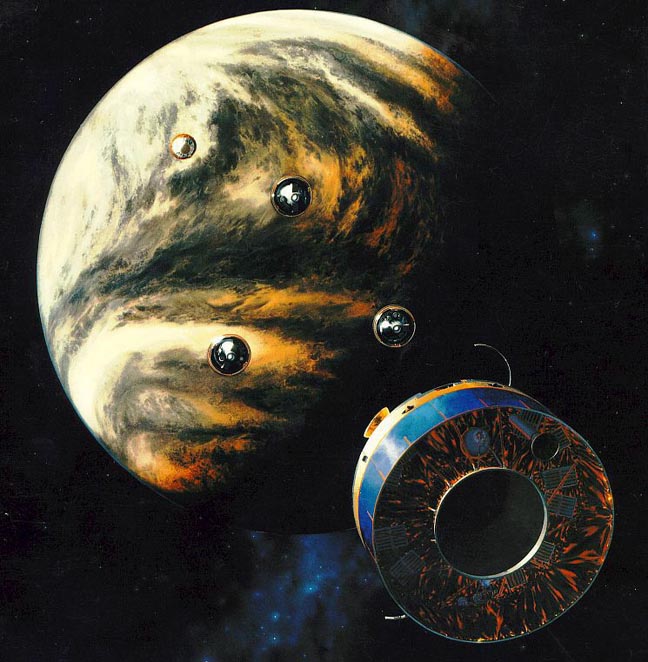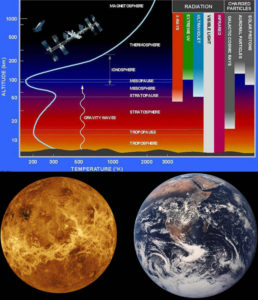Venus atmospheric layers
 Planet Venus, Earth's so called evil twin, is now famous as the origin of greenhouse gases theory and global warming theory. A recent missions data has been interpreted as certain layers in its polar atmosphere having surprisingly colder regions than expected.
Planet Venus, Earth's so called evil twin, is now famous as the origin of greenhouse gases theory and global warming theory. A recent missions data has been interpreted as certain layers in its polar atmosphere having surprisingly colder regions than expected.
What these results reveal is that parts of Venus are much, much colder than expected. The average temperature on Venus makes it the hottest world in the Solar System, with its thick atmosphere trapping heat and giving rise to scorching temperatures of 460°C (860°F) on the surface.
But measurements taken by Venus Express at an altitude of 130 to 140 kilometers (81 to 87 miles) above the surface have revealed the atmosphere near the poles has temperatures far below that on Earth. In fact, the polar atmosphere on Venus drops to -157°C (-251°F), which is 70 degrees colder than expected. It is also 22 to 40 percent less dense than thought.
Death Plunge Of Venus Spacecraft Reveals Surprisingly Cold Temperatures On The Hottest Planet | I Love Science
Just because Venus is meant to be hot does not mean its whole atmosphere has to be but the massive difference in expected cool temperatures is interesting.
Does Venus have atmospheric layers like Earth?
If it does have more defined layers in its atmosphere than predicted what would this mean? How are planets atmospheric layers formed and maintained?
Are these surprising changes in density and lower temperatures due to Venus atmospheric gravity waves?
Waves are ubiquitous phenomena found in oceans and atmospheres alike. From the earliest formal studies of waves in the Earth’s atmosphere to more recent studies on other planets, waves have been shown to play a key role in shaping atmospheric bulk structure, dynamics and variability ...
As the spacecraft flew through Venus’s atmosphere, deceleration by atmospheric drag was sufficient to obtain from accelerometer readings a total of 18 vertical density profiles. We infer an average temperature of T = 114 ± 23 K and find horizontal wave-like density perturbations and mean temperatures being modulated at a quasi-5-day period.
In situ observations of waves in Venus’s polar lower thermosphere with Venus Express aerobraking
If Velikovskian ideas are correct and Venus was recently born as a planet out of Saturn, or Velikovsky inspired plasma comparative mythology that Venus is a newly created or added to our solar system, what would layers mean?
The polar atmosphere is also not as dense as expected; at 130 and 140 km in altitude, it is 22% and 40% less dense than predicted, respectively. When extrapolated upward in the atmosphere, these differences are consistent with those measured previously by VExADE at 180 km, where densities were found to be lower by almost a factor of two.
"This is in-line with our temperature findings, and shows that the existing model paints an overly simplistic picture of Venus' upper atmosphere," added Müller-Wodarg. "These lower densities could be at least partly due to Venus' polar vortices, which are strong wind systems sitting near the planet's poles. Atmospheric winds may be making the density structure both more complicated and more interesting!"
Venus Express' swansong experiment sheds light on Venus' polar atmosphere | European Space Agency
Pluto's atmospheric layers
Are planets atmosphere layers due to electromagnetic and plasma processes and circuits?
Especially when planets like Pluto have strata in their atmospheric environments?
The presence of methane, a powerful greenhouse gas, in Pluto's atmosphere creates a temperature inversion, with the average temperature of its atmosphere tens of degrees warmer than its surface, though observations by New Horizons have revealed Pluto's upper atmosphere to be far colder than expected (70 K, as opposed to about 100 K). Pluto's atmosphere is divided into roughly 20 regularly spaced haze layers up to 150 km high, thought to be the result of pressure waves created by airflow across Pluto's mountains.
Atmosphere of Pluto | Wikipedia
 Caption: One of the Pioneer probes descends through the thick Venusian atmosphere lit by lightning. Image: NASA SP-461. |
||
|
pic of the day Links: Society for
|
Feb 07, 2005 Despite the NASA artist’s depiction above, there has been a reluctance to admit data that points to lightning on Venus. As one report in Sciencemagazine said, “On Venus the clouds tend to resemble fogbanks… You don’t see much lightning in fog.” But when the Galileo spacecraft passed Venus on its way to Jupiter, Science reported with some surprise, “The most striking observations made by the Galileo spacecraft during its flyby of Venus was evidence of lightning.” Earlier reports of lightning tended to be discounted, it seems, because they did not fit the pattern of earthly lightning. The Venera spacecraft found “continuous lightning activity from 32km down to about 2km altitude, with discharges as frequent as an amazing 25 per second.” The highest recorded rate on Earth is 1.4 per second during a severe blizzard. The Pioneer lander recorded 1000 radio impulses. Thirty-two minutes after landing, Venera 11 detected a very loud noise, which was believed to be thunder. The astronomer, Garry Hunt, suggested that “...Venusians may well be glowing from the nearly continuous discharges of those frequent lightning strokes.” The Venusians may be glowing from another effect of electricity as well. At a height of 16km, two Pioneer probes on the night hemisphere detected a “mysterious glow” coming from the surface. The glow increased on descent and was probably caused by a glow discharge on the surface, known on Earth as “St. Elmo’s fire.” See: But the most direct evidence for intense electrical activity in the Venusian atmosphere came as the Pioneer probes descended through clear air. As David Grinspoon wrote in Venus Revealed, “What the hell happened at 12.5 kilometers? Each probe went haywire as it passed through a height of about 12 kilometers, or 7.5 miles, above the surface. The temperature and pressure sensors sent back crazy numbers, power surged throughout the probes, and some instruments stopped functioning entirely.” The NASA report found that “the sensors that failed at almost the same time were made of different materials and their electronics were isolated from each other.” Furthermore, some of the strange readings “can best be explained if the probe became covered with a plasma of charged particles.” The other anomalies “would be consistent with static discharges within or outside the probe, if such were possible.” In the Electric Universe model of Venus such electrical activity is not just possible, it's expected. Many mysteries about Venus can be cleared up with one simple assumption: Venus is a charged body immersed in an electrical circuit. As plasma scientists have known for decades, this means that Venus will be the focus of an invisible cometary style discharge to the solar electrical environment. When spacecraft first encountered Venus’ magnetotail, astronomers described it as “cometary.” When later spacecraft encountered that tail near the Earth, astronomers were surprised that it was so long and comprised of “stringy things.” They expected it to have blown away like smoke in the solar "wind." However, plasma physicists recognized the “stringy things” as Birkeland currents, the typical form, required by the laws of electromagnetism, taken by moving charged particles in plasma. Because the universe is filled with tenuous plasma, Birkeland currents act as invisible “power lines” throughout the cosmos. Electrical energy also powers the intense UV airglow, the “ashen light” and the ionosphere on the dark side of Venus, where the night is 58 Earth-days long. The astronomer Axel Firsoff wrote of the ashen light: “There can be no doubt that the true origin of the Ashen Light is electric. It is a night-sky glow, similar to that in our own sky but estimated to be 50-80 times stronger.” Because this electrical power is being delivered to Venus from external circuits, winds at the cloud tops are driven to 220mph - 60 times faster than the planet surface 40 miles below. This super-rotation of the upper atmosphere mystifies planetary scientists. But it is a “Faraday motor effect” also exhibited by the atmospheres of the Sun, the gas-giant planets, and even Saturn's moon, Titan – Venus’ little brother. The Faraday motor model sees the so-called “magnetic flux ropes” of the solar wind, which are tightly coupled to Venus, as Birkeland currents delivering electric power into the equatorial ionosphere. The Pioneer Orbiter found evidence of the axial part of the circuit at the poles, but that evidence was not recognized as a plasma discharge formation: It was described as “a giant vortex of surprisingly complex structure and behavior” and “one of the more remarkable phenomena in the solar system.” It has the structure of a barred spiral galaxy, which in the Electric Universe represents the grandest scale of plasma discharge. [The next Picture of the Day will discuss the Venus dipole effect in more detail.] The following comment (emphasis added) is from F. W. Taylor of the University of Oxford's Atmospheric, Oceanic and Planetary Physics Department. It illustrates the difficulties faced by theorists who have no training in plasma physics or in electrical engineering and who fail to understand the electrical nature of the universe: “Like the Jovian Great Red Spot, the absence of viable theories which can be tested, or in this case any theory at all, leaves us uncomfortably in doubt as to our basic ability to understand even gross features of planetary atmospheric circulations.” Contributed by Wallace Thornhill |
|
|
Copyright 2005: thunderbolts.info |
||









